Chevron’s plans to increase its crude oil exports from Venezuela have hit a snag, with the sanctioned South American country unable to bear the cost of dredging a key oil export inlet.
Chevron’s Venezuela hopes include ramping up crude oil exports from the sanctioned country—but in order to do that, Lake Maracaibo needs to be dredged. And Venezuela will not purchase the necessary equipment to do the dredging, according to a letter Venezuela sent to Dutch shipbuilder Royal IHC, citing limited funds.
Chevron paid for a measurement of the amount of sediment accumulated at the bottom of the lake—but Chevron could be forced to pay for the dredging as well if it wants to increase its exports.
Chevron asked Venezuela to dredge the inlet to prevent ships from running aground as it attempts to fulfill its ambitions of exporting between 400,000 bpd and 500,000 bpd of crude oil out of Venezuela. The U.S.-based company’s current Venezuelan exports stood at 300,000 bpd, according to Bloomberg, but this is already a significant increase from Chevron’s January export rate of 100,000 bpd.
Venezuela’s heavy crude oil is prized by Gulf Coast refiners, who, until recently, looked to Russia’s heavy grades to replace it. Last December, it was reported that several refiners were attempting to get their hands on the rare Venezuelan crude oil.
The Biden administration eased sanctions on Venezuela to allow Chevron to resume its work in Venezuela when access to Russian heavy crude was shut off by the new sanctions.
In November, the government granted Chevron a six-month license to operate in Venezuela under its joint ventures with PDVSA there. Profits from the sale of Chevron’s Venezuelan-derived crude oil will go towards paying down its debt to Chevron and will not bolster state-run PDVSA’s profits.


Comment here